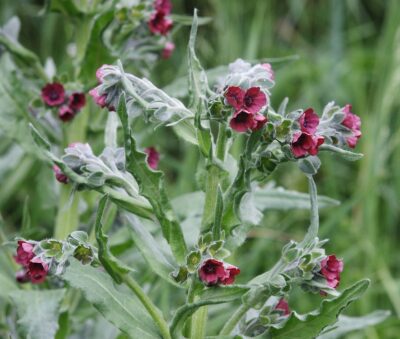By Blaine Bug Crew
 Picture a bright sunny morning with you and your dog out on a hike. Along the sides of the trail are plants that have beautiful reddish-purple flowers. Your dog brushes against them several times and so do you. As you get back to your car, you and your dog both have prickly seeds all over you that are stuck to you like Velcro. You just came into contact with a noxious weed, houndstongue.
Picture a bright sunny morning with you and your dog out on a hike. Along the sides of the trail are plants that have beautiful reddish-purple flowers. Your dog brushes against them several times and so do you. As you get back to your car, you and your dog both have prickly seeds all over you that are stuck to you like Velcro. You just came into contact with a noxious weed, houndstongue.
Houndstongue is a biennial, or short-lived perennial, which reproduces by barbed seeds that readily adhere to fur, hair and wool. The first year, the plant develops a rosette with hairy, linear leaves that range from 10-30 cm in length. Plants typically grow from 35-140 cm tall the second year. The reddish-purple, five-lobed flowers bloom June through August. Each plant produces an average of 500 seeds which are composed of four prickly nutlets, each approximately 1 cm in length. Houndstongue’s ability to spread has created serious problems on rangeland and pastures where the plant quickly colonized disturbed sites and heavily grazed areas in riparian zones. Houndstongue contains pyrrolizidine alkaloids, making it poisonous to livestock and horses. Fortunately, we are preparing for the arrival of a seed-feeding weevil that helps prevent houndstongue.
Mogulones borraginis is a seed-feeding weevil that eats houndstongue seeds. Like other seedhead feeders, this predator reduces the number of seeds produced by the plant each year. However, until these insects are readily available and proliferated throughout the state, it is landowners, land managers and the public that need to prevent the spread of this noxious weed. Dogs and livestock are carriers of this noxious weed because the seeds stick to their fur like Velcro.
If you notice an infestation of this noxious weed in your travels, please call Kay Draper at the Blaine County Weed Department at (208) 788-5543 to help keep Blaine County native.



